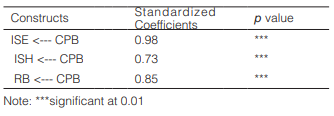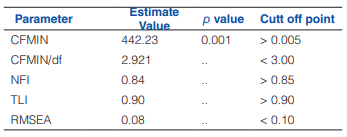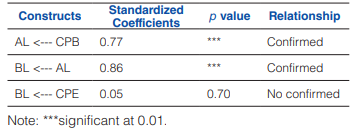Introduction
Universities, as well as other service organizations, face current obstacles to their effective functioning, future development, and even corporate survival. Such situation has led them to adopt a market-oriented trend, which includes marketing practices with the primary objective to obtain student’s loyalty, not only to avoid drop-ping out, but also to obtain positive consequences such as the recommendation, the return for new courses and assistance to the university after graduation (Arboleda & Alonso, 2017).
Despite the controversy regarding whether university students should be treated as clients, in aspects such as services, employee performance and administrative processes, students see themselves as clients of their university (Arboleda & Alonso, 2017). To obtain customer loyalty, the level of consumer involvement is paramount, as it moderates the relationships between the benefits expected by the customer and their attitude towards the firm. Thus, it is crucial to study the relationship between participatory behavior and loyalty (Foroudi, et al, 2019).
Jiang, et al. (2019), found that the participatory behavior of the consumer is encouraged by the service provider, and it exerts a great impact on the value perceived by the consumer. The concept of participatory consumer behavior has been lately used in research that seeks to understand in depth the relationships between suppliers and their customers, especially their antecedents and consequences, in fields such as the development of new products, and new services (Wang, et al., 2019). Participatory behavior has been related to consumer loyalty, however, further research on its antecedent and consequences is needed (Prior, et al., 2019), on new measures to stabilize their results and their use in the higher education field (De Silva & Rossi, 2018).
Watson, et al. (2015), proposed a theoretical framework in which loyalty is a con-struct made up of attitude and behavior. When trying to measure attitudinal loyalty and behavioral loyalty as two separate constructs, there is a marked trend in their characteristics. Word of mouth recommendation is considered a component of attitudinal loyalty and currently the concept has spread to communications on social networks which have a larger multiplying power, giving it even greater importance. In addition, repeated purchases, and the intention to continue buying a certain brand are considered a part of attitudinal loyalty (Foroudi, et al., 2019).
In the marketing field, the attitudinal and behavioral components of loyalty have been investigated separately recently in different industries such (El-Adly, 2018; Yao, et al., 2019). Loyalty has been studied in the context of higher education, nonetheless, it takes additional research to understand its characteristics within that context, in addition to studying its antecedent. (Arboleda & Alonso, 2017).
Based on scientific literature review, the research proposes participatory behavior as an antecedent of loyalty, considering the latter as two separate constructs, attitudinal loyalty, and behavioral loyalty, where attitudinal loyalty is acting as a mediator between participatory behavior and behavior. behavioral loyalty, creating a theoretical model shown in Fig. 1.
Delpechitre et al., (2018) used the criteria of participatory consumer behavior and showed as a result the commitment of customers and the importance of sharing in-formation. The theory of planned behavior (TCP) stated that the attitude towards a behavior is a predictor of the performance of said behavior, if it is believed that it would obtain some positive value for itself, in addition to having the references of other reliable people (Ajzen, 1991).
Several researches introduced the attitudinal component in loyalty, acknowledging that a positive attitude towards the target brand was necessary to achieve true loyalty and not spurious loyalty. Until that moment, loyalty was exclusively related to repetitive purchases. A research based on the theory of planned behavior has pointed to attitudinal loyalty as an antecedent of behavioral loyalty (Yeo, et al., 2017). They found links between participatory behavior and the intention to speak well of the firm and recommend it, behaviors related to attitudinal loyalty, therefore:
H1: The participatory behavior of university students towards the university has a direct and positive relationship with their attitudinal loyalty towards the university.
Hariharan, et al. (2018), defined behavioral loyalty as the consistency disclosed in choosing a brand over several purchase occasions. Watson, et al. (2015), highlighted that behavioral loyalty has to do with an orientation to action to favor a brand and it influences the performance of the firm. Behavioral loyalty measurement through repetitive purchases can be replaced by purchase intentions, since in many cases the action cannot be seen. This represents a purchase action or purchase intention, but based on the TPB it was stated that attitudes are predictors of behaviors, and by extending this concept to loyalty, it is proposed that first there must be a positive attitude towards that behavior, therefore:
H2: The attitudinal loyalty of university students towards the university has a direct and positive relationship with their behavioral loyalty towards the university.
Attitudinal loyalty has an affective nature, and it is reflected in the positive recommendation (Yao, et al., 2019), adding that modern communication technologies have resulted in the recently implemented electronic recommendation, which due to its scope can be more influential than the traditional word of mouth. (Balaji, et al., 2016). This positive attitude becomes a predictor of consequent behavior, due to the mediating effect of attitudes on behaviors (Ajzen, 1991), minimizing the effect of spurious loyalty, therefore, a total, positive and positive mediation is expected, there-fore:
H3: The attitudinal loyalty of university students towards their university has an overall mediating effect between their participatory behavior and their behavioral loyalty towards the university.
The present research relevance lies in increasing knowledge about the antecedents of loyalty because despite decades of study as a construct, there is still a lack of knowledge of its nature in the field of services and especially in education (Balaji, et al., 2016). In addition, it will contribute to gain knowledge about the predictive effect of the attitude on the behavior regarding the loyalty of the service consumer, a situation that requires new research (Yeo, et al., 2017; Hariharan, et al., 2018; Yao, et al., 2019). The scientific literature on the benefits of participatory behavior by consumers of a service will increase, which requires further research (Jiang, et al., 2019) and especially in the context of higher education (De Silva & Rossi, 2018; Foroudi, et al., 2019).
Materials and methods
The research design was cross-sectional, non-experimental, through data collection with a self-reported questionnaire. A structural equation model and the maximum likelihood estimator was used to display the relationships between the constructs of participatory consumer behavior, attitudinal loyalty, and behavioral loyalty. The design is convenient because it allows showing relationships between constructs, as well as their magnitude and significance. Research recently carried out has used a non-experimental design with surveys and a structural equation model studying participatory behavior (Chen & Liu, 2019; Jiang, et al., 2019) and attitudinal and behavioral loyalty (Yeo, et al., 2017; Yao, et al., 2019).
The data were collected in the city of Guayaquil, Ecuador, at four different universities. The unit of analysis were undergraduate university students, who were in their last semester and actively taking the entire course. The sample was of convenience, however, Calder, et al. (1981), made a distinction between the objectives of an investigation and probability sampling, when the objective is to show relationships be-tween constructs of a theoretical model, it is more important that the study subjects are homogeneous and meet the characteristics required by the objectives of the investigation. This is especially applicable in consumer behavior studies.
The sample size was of 237 observations, which is valid following the recommendations of Shi, et al. (2018), in the sense that when the model is properly specified, this number of observations in a model of 22 observable variables such as the pro-posed one, provide a reasonable estimate for the indexes to be used. The characteristics of the respondents can be seen in Table 1.
The instruments used to carry out the research were taken from previous research, for the participatory behavior construct the questionnaire developed by Yi & Gong (2012), was used, which considers it as a second-order construct with four first-order constructs that are: search for information with three items, share information with four items, responsible behavior with four items and personal interaction with five items. For the attitudinal loyalty construct, items developed by Balaji, et al. (2017), and for the behavioral loyalty construct, four items developed by Arboleda & Alonso (2017), were chosen, and four items developed by Rauschnabel, et al. (2016). The questionnaire was translated from its original language into Spanish and back into English to test its consistency. Additionally, a panel of experts was used to examine each question to obtain content validity. Subsequently, a semantic test was carried out with 15 participants to ensure that the questions were clearly understood. A pilot test with 45 students was also carried out to verify the internal consistency of the questionnaire items in general, which obtained a Cronbach's Alpha of 0.87 considered very good.
Regarding ethical aspects, informed consent was used, and the participants were informed that the shared data would be confidential and solely used for academic purposes. The survey was answered at the workplace of the participants, where the instructions were given using psychological distance to minimize the bias of the common method (Podsakoff, et al., 2012).
Results and discussion
Once the results were obtained and using the SPSS 25 statistical program, the necessary tests were carried out to ensure the assumptions in a structural equation model under the maximum likelihood estimator. The normality test concluded that the asymmetry and kurtosis values were within the tolerable range. The bivariate correlations showed that there were no correlations greater than 0.85 among the observable variables, thus, the problem of multicollinearity was ruled out. The measures taken in the collection of the information and its first review eliminated the problem of missing data. The extreme values were treated with the Mahalanobis distance, showing some extreme data, which were eliminated, thus helping the multivariate normality.
Once the data proved to be suitable, the AMOS 22 program was used to proceed with a confirmatory factor analysis, to establish validity and reliability. The model specification can be seen in Fig. 2. The constructs exceeded the suggested indexes for the mean variance extracted and for the composite reliability. The criterion of Forner and Larcker determined the discriminant validity. In addition, standardized correlations between main constructs, using a t-test, were statistically different from one. This showed reliability, convergent validity, and discriminant validity. To analyze the factorial loads of the relationship between constructs, standardized coefficients greater than 0.6 were considered, and any indicator with loads less than this value were removed.
The measurement model (Table 2) was tested with the chi-square, which was shown to be significant and therefore there was no adjustment between the model and the data, however, due to the sensitivity of this statistic to the sample size, incremental fit measures were used. These measures were the normed fit index (NFI), the non-normed fit index or Tucker-Lewis’s index, and the quadratic error (RMSEA), in addition to the chi-square divided by the degrees of freedom as a measure of parsimony. The latter did not reach the cut-off points satisfactorily, for which the model was modified. For the modification, indexes with values out of the normal range were considered, to obtain a model with a better fit, which was achieved, but losing a first order construct in the CPE, the search for information, and two fewer measurement variables in the behavioral loyalty construct. The results of the model's fit indexes can be seen in Table 4.
The relationship between main constructs was of sufficient magnitude and statistically significant as seen in the results shown in table 2. Regarding the relationship of the first order constructs of participatory behavior, they were significant and of sufficient magnitude (Table 3).
The results of the relationships between the model variables were used to test the hypotheses, which are described below.
Hypothesis 1: Student participatory behavior has a direct effect on attitudinal loyalty
The relationship between the student's participatory behavior construct and the attitudinal loyalty construct resulted in a standardized coefficient of 0.83, which is considered excellent, in addition to having statistical significance, as seen in the data of Table 5.
Hypothesis 2: Attitudinal loyalty has a direct effect on behavioral loyalty.
The analysis tests of the structure model showed a regression coefficient of 0.92 which is considered excellent, in addition to being significant, as shown in Table 6. This leads to the conclusion that attitudinal loyalty has a direct relationship, positive, large, and significant, which supports Alternative Hypothesis number two.
Hypothesis 3: Attitudinal loyalty has a total mediating effect between participatory behavior and behavioral loyalty.
To observe the mediating effect of the attitudinal loyalty variable, a partial mediation model was tested, obtaining a standardized coefficient of very low magnitude and not significant. In contrast, the total mediation of attitudinal loyalty between participatory behavior and behavioral loyalty resulted in large and significant coefficients, as shown in Table 7.
The results showed that the relationship between participatory behavior and attitudinal loyalty is direct, significant, and positive. This shows that when a consumer adopts a favorable tendency to participate in the service delivery processes by an organization, a positive attitude towards it is developed, and there is willingness to recommend it (Foroudi, et al., 2019). Research subjects also showed attitudinal loyal-ty as a predictor of behavioral loyalty, with a direct, significant, and positive influence, which is consistent with results obtained by other investigations (Cossío-Silva, et al., 2016), however, they conflict with results that take loyalty as a one-dimensional construct in whose measurement the intention to recommend prevails (Chen & Liu, 2019).
At the construct level, the research explored the multidimensional nature of participatory behavior. Personal interaction was eliminated from the model, and this may be due to the increasingly widespread habit among students of carrying out interactions virtually, a practice that is even encouraged by higher education institutions (De Silva & Rossi, 2018).
The research showed electronic recommendation as a reliable measure of attitudinal loyalty, which is in line with the results obtained by recent research (El-Adly, 2018). Regarding behavioral loyalty, the intention of using the service again and having the conviction that the same institution would be chosen again in case the decision was faced again, also constitutes a reference for later research that focuses on attitudinal loyalty as a future intention and not something tied to past events (Hariharan, et al., 2018).
The model eliminated alumni support for their former educational institution, in contrast to previous research that concluded that alumni support is part of their loyal-ty (Rauschnabel, et al., 2016). For this, two readings are proposed, one of them is that these actions can be considered as an independent construct, and the other, that it is possible that in the social and cultural context in which the research was carried out, these practices are not rooted, and they do not represent a significant factor in the estimation that students have about their relationship with the university once they have already graduated. In general, the results are a starting point to use the relation-ship between the three constructs as a model to understand customer loyalty, to un-derstand value creation better and contribute to attempts to establish a general theory of marketing
Conclusions
In the first place, since it is evident that all exchange activities arouse emotions that create strong ties with the organization, it is important that they know in depth the experiences to offer to their consumers, and that they guide their efforts to build a brand that evokes an image as well as the perceived benefits of great value, for this, they must inquire about their expectations, and the new information technologies and social networks must be used at the maximum for this purpose. Second, since the work of marketers has become more complex as they now require a holistic perspective when developing their strategies (Rauschnabel, et al., 2016), managers should consider all aspects of participatory behavior, and include them in their planning to take all possible actions to encourage it, which is in accordance with other studies, when they pointed out that it was necessary to establish favorable conditions for the exchange of resources between the client and the organization.
Third, administrators must strengthen interaction and not just post or request in-formation on their web pages, with enough encouragement to share their personal experiences. The creation of communities would facilitate communication and the exchange of experiences, and it would constitute a source of information that, with appropriate data analysis techniques, would serve as inputs to develop strategies. Fourth, in the specific case of universities, it is necessary to recruit people capable of building the university brand and disseminating it, since students who know better the characteristics of their university engage in participatory behaviors (Balaji, et al., 2016).
The present research was carried out in the context of higher education in Ecuador at the undergraduate level. Further research could also show if there are significant differences between students from public and private universities, as well as if there are differences between genders. Replications of this study in different populations and in different contexts, would improve the knowledge of the variables and would facilitate the generalization of the results.
























